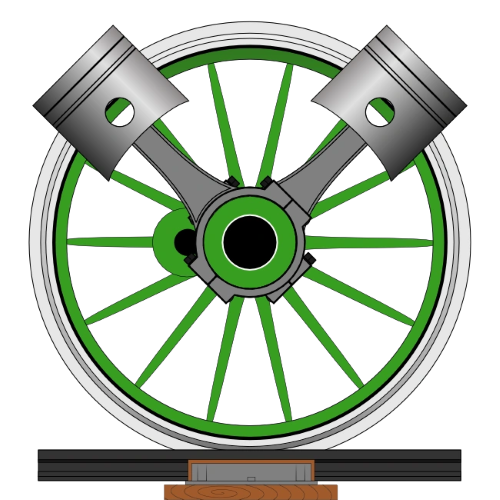
An NCDOT F59PHI.
The EMD F59PHI is a semi-high speed locomotive produced by Electro-Motive Division (EMD) from 1994 to 2001. It features an isolated cab, lightweight body, and a streamlined shape, features that were absent on the original commuter F59PH it was built from.
First built for the California Department of Transportation (CDOT), the F59PHI has seen service in all four corners of America, (Mostly seen in California) as well as in the Pacific Northwest/Montreal area in Canada. A total of 83 were built.
History[]
In 1990, the State of California passed a bill that would result in massive funding for the state transportation systems. It also resulted in a separate, state funded system of regional Amtrak routes.
Caltrans wanted a locomotive that was both reliable and attractive. They approached EMD, who responded with the lightweight, high-speed F59PHI locomotive. The North Carolina Department of Transportation also selected it as their primary motive power. West Coast Express (operated by TransLink) in Metro Vancouver, selected it for starting up its service.
San Diego's Coaster Commuter rail ordered two F59PHI locomotives (3001-3002) in early 2000s and were delivered and entered service in 2001. 3002 retired in February 2021 due to engine failure and 3001 is scheduled to retire soon in favor of the Siemens Charger. As of October 25, 2021, the two NCTD F-59s were reactivated and are operating until retirement in 2023.
Montreal's Réseau de transport métropolitain (also known as Exo) bought 11 of these locomoties to go with their Bombardier BiLevel coaches, which were just arriving.
The F59PHI was produced until 2001. It was taken off of EMD's lineup because it wasn't able to meet the EPA Tier 1 regulations.
Amtrak California's F59PHI's have been rebuilt by EMD, these are ECO repowers.
Sound Transit's 2015 budget outlines plans to overhaul seven F59's and four of those will be overhauled to Tier 3 standards.
Amtrak retired all of their F59PHI locomotives on the Surfliner and Cascades service from September 2018 to March 2019 in favor of the Siemens Charger. This won't be the end of their careers, though, as they will be shifted of to Metra in Chicago renumbered 73-93. The majority of the locomotives owned by California will remain in Capitol Corridor and San Joaquins service, while North Carolina has made no announcement regarding any plans to replace their own fleet, although on May 22, 2020, it was announced that the NCDOT will receive an $80 million dollar grant to order 6 new locomotives to replace the remainder of the current fleet. All F59PHIs on the Amtrak system (Except Caltrans and NCDOT) were retired during 2019.
In May 2020 Metrolink retired all their F59PHI locomotives in favor of the EMD F125.
Railfans generally agree that the horns on the F59PHIs are among the worst on the Amtrak Surfliner system. This is primarily due to the horn being placed directly behind the exhaust stack, causing the horn's sound to become distorted by the exhaust, as well as fouled and dirtied by the exhaust. The horns were placed in this location after engineers on F40PH locomotives complained of sound vibrations from the roof-mounted horns.
Quantity[]
- Metrolink: 0 874-887 (14 locomotives) retired in 2020
- Coaster: 1 - 3001, 3002 (2 locomotives) 3002 retired in February 2021 due to mechanical failure. 3001 will likely be a yard switcher.
- Trinity Rail Express: 569-570 (2 locomotives)
- Sounder: 901-911 (11 locomotives)
- RTM/Exo: 1320-1330 (11 locomotives)
- North Carolina Department of Transportation: 1755, 1797 (2 locomotives)
- Caltrans (California DoT): 2001-2015 (14 locomotives)
- West Coast Express: 901-905 (5 locomotives)
- Metra: 73-93 (21 locomotives)
Differences between the F59PHI and the original F59PH[]
The differences between these two locomotives are only skin-deep. Most features introduced on the F59PH, like the separate HEP genset, were carried over to the F59PHI. However, differences include:
- A lighter, streamlined body (made of fiberglass and composite material)
- An increase in horsepower (12V710G3C-EC engine compared to the F59PH's 12V710G3A)
- 3200 hp vs 3000 hp
- Isolated cab (hence the "I" in its designation)
- Increased speed (max speed: 110 mph)
Trivia[]
In the new 2021 business plans, Caltrans stated that they ordered 2 new Siemens SC-44 Charger locomotives to replace 2 F-59 locomotives, the new locomotives are expected to arrive in 2021. These will replace 2 F59PHI locomotives on the Capitol Corridor with a option of up to 5 more by 2023. However it won't be the end of their careers though, due to them planned to be "Non-powered Control units(NPCU)" Cab control cars for future Amtrak California Intercity rail service.
